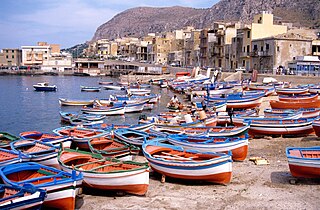
Bagheria is a city and comune in the Metropolitan City of Palermo in Sicily, located approximately 10km to the east of the city centre.

Antonio Sant'Elia was an Italian architect and a key member of the Futurist movement in architecture. He left behind almost no completed works of architecture and is primarily remembered for his bold sketches and influence on modern architecture.

Villa del Poggio Imperiale is a predominantly neoclassical former grand ducal villa in Arcetri, just to the south of Florence in Tuscany, Central Italy. Beginning as a villa of the Baroncelli of Florence, it was seized by the Medici, became the home of a Medici princess, and a lavish retreat for a Grand Duchess with imperial pretensions. Later given to Napoleon's sister, it was reclaimed by the hereditary rulers of Tuscany before being finally converted to a prestigious girls' school. During its long history, it has often been at the centre of Italy's turbulent history, and has been rebuilt and redesigned many times.
Purismo was an Italian cultural movement which began in the 1820s. The group intended to restore and preserve language through the study of medieval authors, and such study extended to the visual arts.

Villa Barbaro, also known as the Villa di Maser, is a large villa at Maser in the Veneto region of northern Italy. It was designed and built by the Italian Renaissance architect Andrea Palladio, with frescos by Paolo Veronese and sculptures by Alessandro Vittoria, for Daniele Barbaro, Patriarch of Aquileia and ambassador to Queen Elizabeth I of England and his brother Marcantonio, an ambassador to King Charles IX of France. The villa was added to the list of World Heritage Sites by UNESCO in 1996.
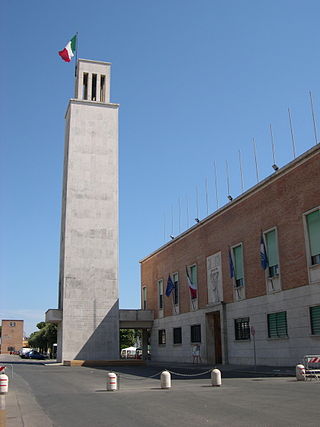
Sabaudia is a coastal town in the province of Latina, Lazio, in central Italy. Sabaudia's centre is characterised by several examples of Fascist architecture. Villa Volpi, a neoclassical seaside villa built for Countess Nathalie Volpi of Misurata, is located on the sand dunes of Sabaudia.

Moscazzano is a comune (municipality) in the Province of Cremona in the Italian region Lombardy, located about 45 kilometres (28 mi) southeast of Milan and about 30 kilometres (19 mi) northwest of Cremona.

Maltese architecture has its origins in prehistory, and some of the oldest free-standing structures on Earth – a series of megalithic temples – can be found on Malta. The islands were colonized by the Phoenicians and later the Romans, who established the cities of Melite and Gaulos. Although these were substantial settlements and are known to have had numerous temples, churches and palaces, few remains have survived apart from some architectural fragments.
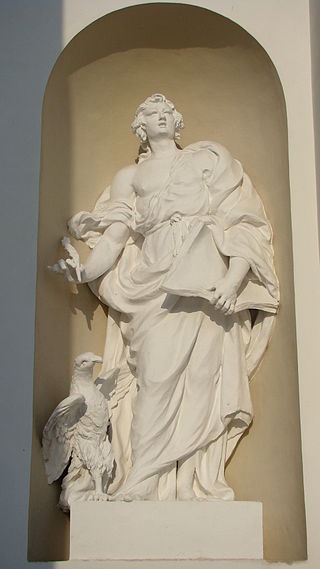
Tommaso Righi (1727–1802) was an Italian sculptor and stuccator with a practice in Rome. His marble and stucco funeral monument to Carlo Pio Balestra, patron of the Church of Santi Luca e Martina, in the Roman Forum, is probably his most prominent commission. His monument of cardinal Camillo Paolucci stands in a chapel of San Marcello al Corso, where its design was constrained by its having to form a pendant to the baroque monument facing it, of Fabrizio Paolucci, by Pietro Bracci (1726). A great work, less often seen, is his altarpiece in the Church of S. Maria del Priorato, the chapel of the Villa of the Sovereign Military Order of Malta: Piranesi provided the design, and Righi executed the great globe surrounded by putti in clouds, and Saint Basil in Glory supported by two angels. His bas-relief panel appears among a host by others, in the central Sala degli Imperatori of the Galleria Borghese, part of the rearrangement of the interiors of the Villa Borghese undertaken in 1782 by prince Marcantonio Borghese.
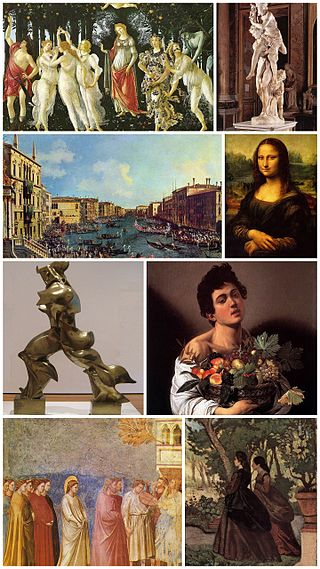
From the second half of the 18th century through the 19th century, Italy went through a great deal of socio-economic changes, several foreign invasions and the turbulent Risorgimento, which resulted in the Italian unification in 1861. Thus, Italian art went through a series of minor and major changes in style.

Italian modern and contemporary architecture refers to architecture in Italy during the 20th and 21st centuries.

Ettore Tito was an Italian artist particularly known for his paintings of contemporary life and landscapes in Venice and the surrounding region. He trained at the Accademia di Belle Arti in Venice and from 1894 to 1927 was the Professor of Painting there. Tito exhibited widely and was awarded the Grand Prize in painting at the 1915 Panama–Pacific International Exposition in San Francisco. In 1926 he was made a member of the Royal Academy of Italy. Tito was born in Castellammare di Stabia in the province of Naples and died in Venice, the city which was his home for most of his life.

The Villa Traversi Tittoni, or Villa Cusani Traversi Tittoni is a rural palace in Desio, northern Italy.
Tommaso Maria Conca (1734–1822), was an Italian painter and draftsman, active mostly in Rome.
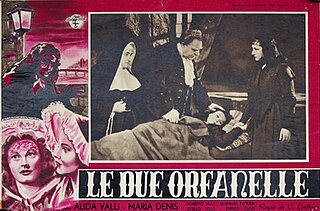
The Two Orphans is a 1942 Italian historical drama film directed by Carmine Gallone and starring Alida Valli, María Denis and Osvaldo Valenti. It was based on the play The Two Orphans by Adolphe d'Ennery and Eugène Cormon, one of many film adaptations. It was made at Cinecittà Studios in Rome. The film's sets were designed by the art director Guido Fiorini.

The Villa Gallarati Scotti is a rural palace located near the town of Vimercate, in the Province of Monza and Brianza, in the Region of Lombardy, Italy.

San Niccolò al Carmine, also called Santa Maria del Carmine is a Renaissance style, Roman Catholic church and monastery located in Pian dei Mantellini #30, near the corner of Via della Diana in the Terzo de Citta of Siena, region of Tuscany, Italy. The church now serves as the Oratory for the Contrada of Pantera. Across the street from the belltower is the Palazzo Celsi Pollini. North along Pian dei Mantellini, toward the Arco delle Due Porte, and on the same side of the street are a number of palaces built around what was once the Monastery of the Derelict Women: in order they are the Neoclassical Palazzo Incontri, the Palazzo Ravissa and the Palazzo Segardi.

Giovanni Battista Marchetti (1730–1800) was an Italian painter, active mainly as a decorative fresco painter in a neoclassical-style in Siena and Rome.
Monumentalism defines the architectural tendencies that during the first half of the twentieth century had as their essential canon the inspiration and connection to classicism and neoclassicism. Critics divide this architecture into two streams: Neo-Baroque and Simplified Neoclassicism.




















